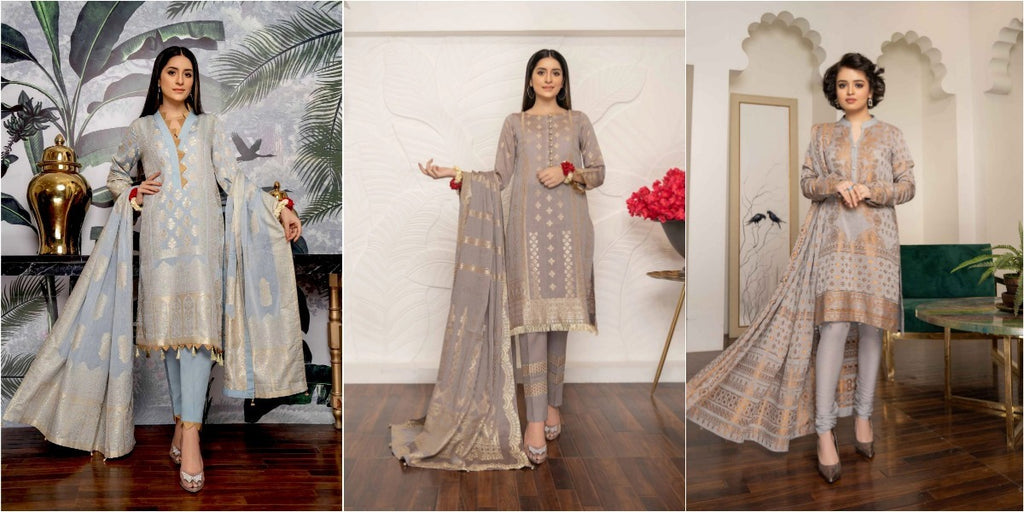5 Crucial Things That Make Jacquard The Most Unique Fabric
Posted by YOUR LIBAAS

If you are into ethnic fashion, the chances are that you have already seen jacquard fabric without realising it. This type of material has an intricate woven pattern which is not embroidered but woven directly into the fabric. It gets manufactured by a special loom which also produces other materials like brocade and damask. Although jacquard might have become a common sight in the markets today, this was not the case always. It is such a rare and unique material that even the term “Jacquard” indicates how the pattern gets woven, not the specific design itself.
A History of Jacquard - To Loom & Beyond

A process called draw-loom was used to weave designs before the 1800s, but it was a prolonged process and could only get used for simple designs. The wealthy members of the society could only afford the delicate, intricate fabrics, and hence they became a symbol of status and wealth. However, this situation changed drastically in 1801 with the coming of Jacquard loom named after its inventor Joseph Marie Jacquard. He wanted to create a more efficient machine which required less labour and could create an artistic design in fabrics.
Jacquard loom fulfilled all these criteria as it made use of punched wooden cards to weave a pre-designed pattern into the fabric. In the 1980s, there was a surge in production with the invention of electronic jacquard looms which eliminated the repetitive need to weave the fabric. A significant improvement hence came in production time and quality, which further lead to the fabric’s popularity.
Why Is Jacquard So Unique?

Patterns due to prolonged usage are prone to fading, pattern stretching or rubbing of altogether when they are stamped or printed on the surface of the fabric. However, a jacquard pattern is here to stay because it is a part of the material weaves itself so it won’t change despite the daily wear and tear.
The part that makes this material so unique is that some of them are even reversible hence promising more versatility than a printed pattern. From floral and damask to polka dot and plaid, you are sure to find a jacquard pattern that resonates with you. Moreover, as this material gets woven into the fabric, each yarn can be solution-dyed making it more fade resistant than topically dyed yarns.
Types of Jacquard Fabric

Apart from the patterned jacquard fabric woven with the help of loom, this material can get further sub-divided into three types.
Brocade Fabric - This material gets used explicitly in fashion clothing and upholstery. It is an elaborately patterned raise fabric woven with multi-coloured threads. It helps in producing much more vibrant designs.
Damask Fabric - This is a more delicate and sheer version of brocade. It is also a patterned fabric but mostly woven with a single colour. It gets generally used in fibre blends or synthetic fibre production.
Matelasse Fabric- This material gets manufactured using cotton, silk or rayon. It has a quilted effect and a stretchy surface.
Variety & Uses of Jacquard
From ethnic to western wear, jacquard covers all fashion clothing categories. It got specifically proved at Lakme Fashion Week where the show was a full-on display of jacquard knee-length dresses and jumpsuits. Not only this but this fabric looks beautiful in sarees, lehengas, pantsuits ethnic jackets, blouses and kurtas. Floral and jacquard is one mesmerising combination that consistently gives us major fashion inspiration.
The versatility of this material is undeniable, and hence it’s not only limited to garments but goes beyond to accessories and home decor too. Luxury brands like Gucci, Jimmy Choo, Louis Vuitton and more have justified the use of jacquard for beautiful accessories like bags, shoes, wallets, hairbands etc. More than 50% of bed covers, pillow or cushion covers, bed sheets, towels are made of this fabric only.
Maintenance & Care of Jacquard Fabric

Jacquard is a fabric that doesn’t require extra efforts to look clean and taken care of. If you wish to dry clean this material, then you can use a soft brush or a vacuum cleaner for the same. For wet cleaning, you can even use a damp sponge. During drying, it’s essential to avoid direct sunlight. You should also avoid using various chemicals on the fabric or rubbing it too hard because that might damage its texture.
Jacquards which got earlier made of silk now get made from different kinds of fibres. It’s a complex textured material and worth buying. Did jacquards capture your attention now? You are in luck! We at YourLibaas offer hundreds of ethnic wear in this fabric which you can easily order and compare with other designs and colour schemes.
— By Anushka Batra
Posted on 17th September, 2022 at YourLibaas
